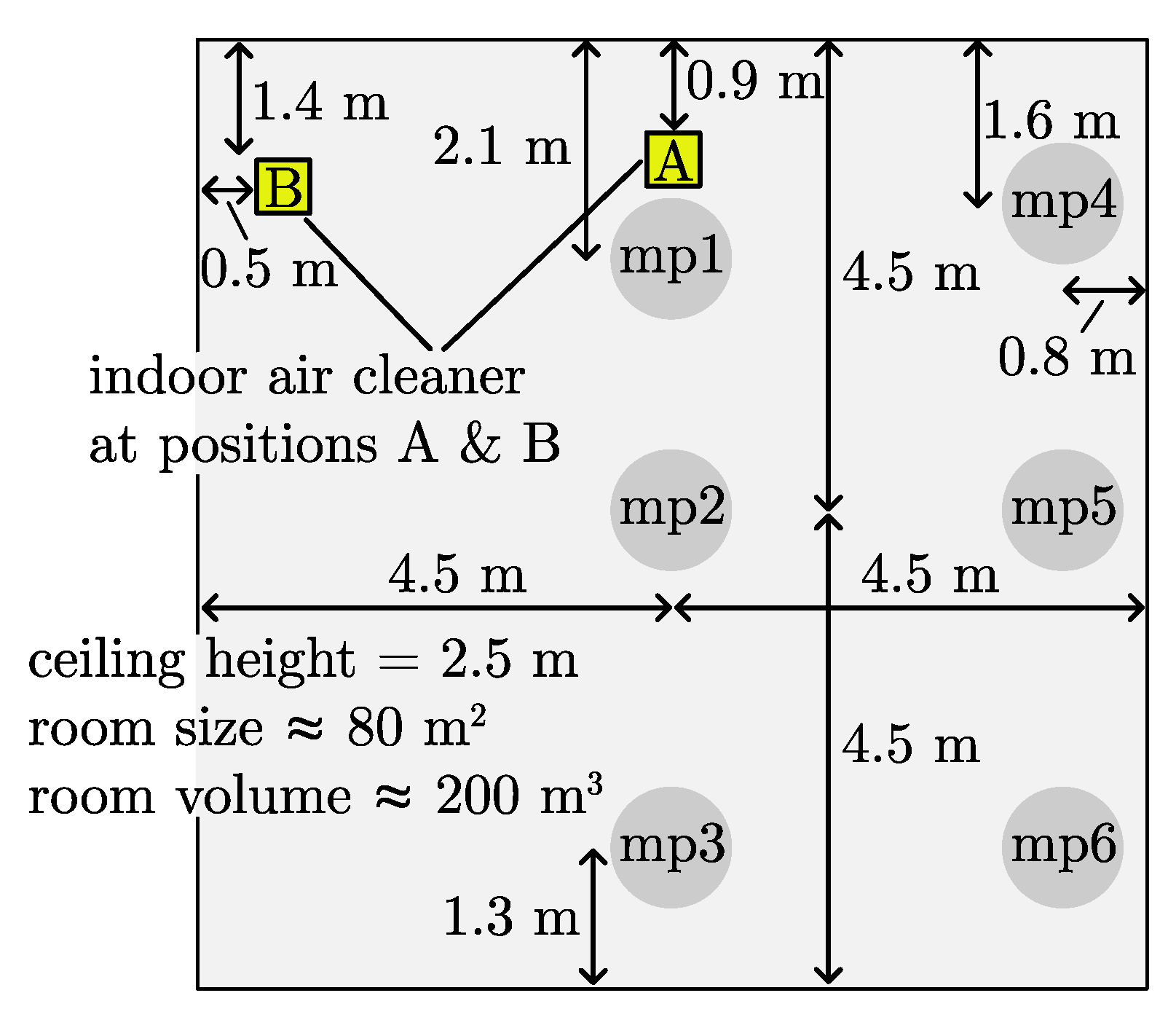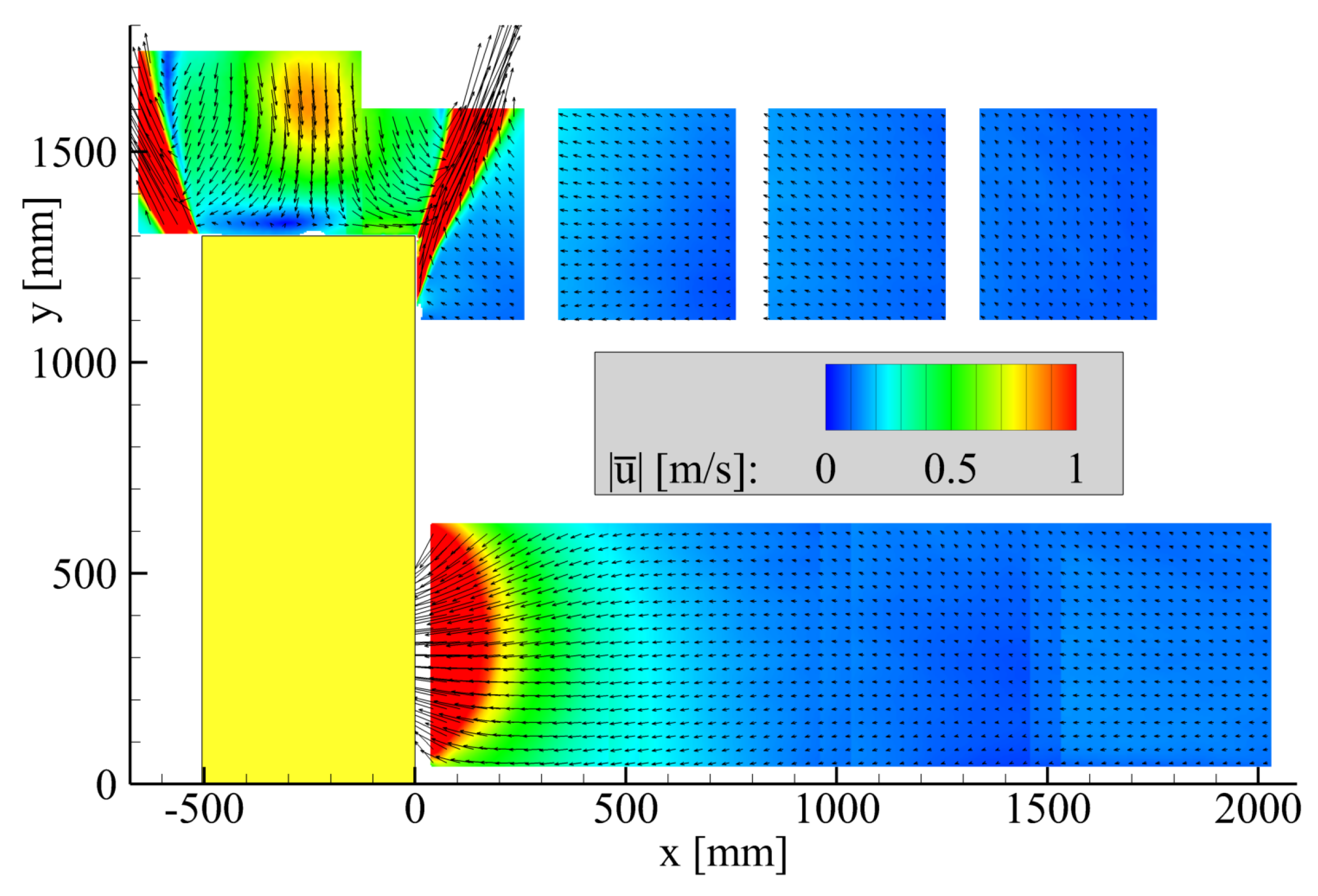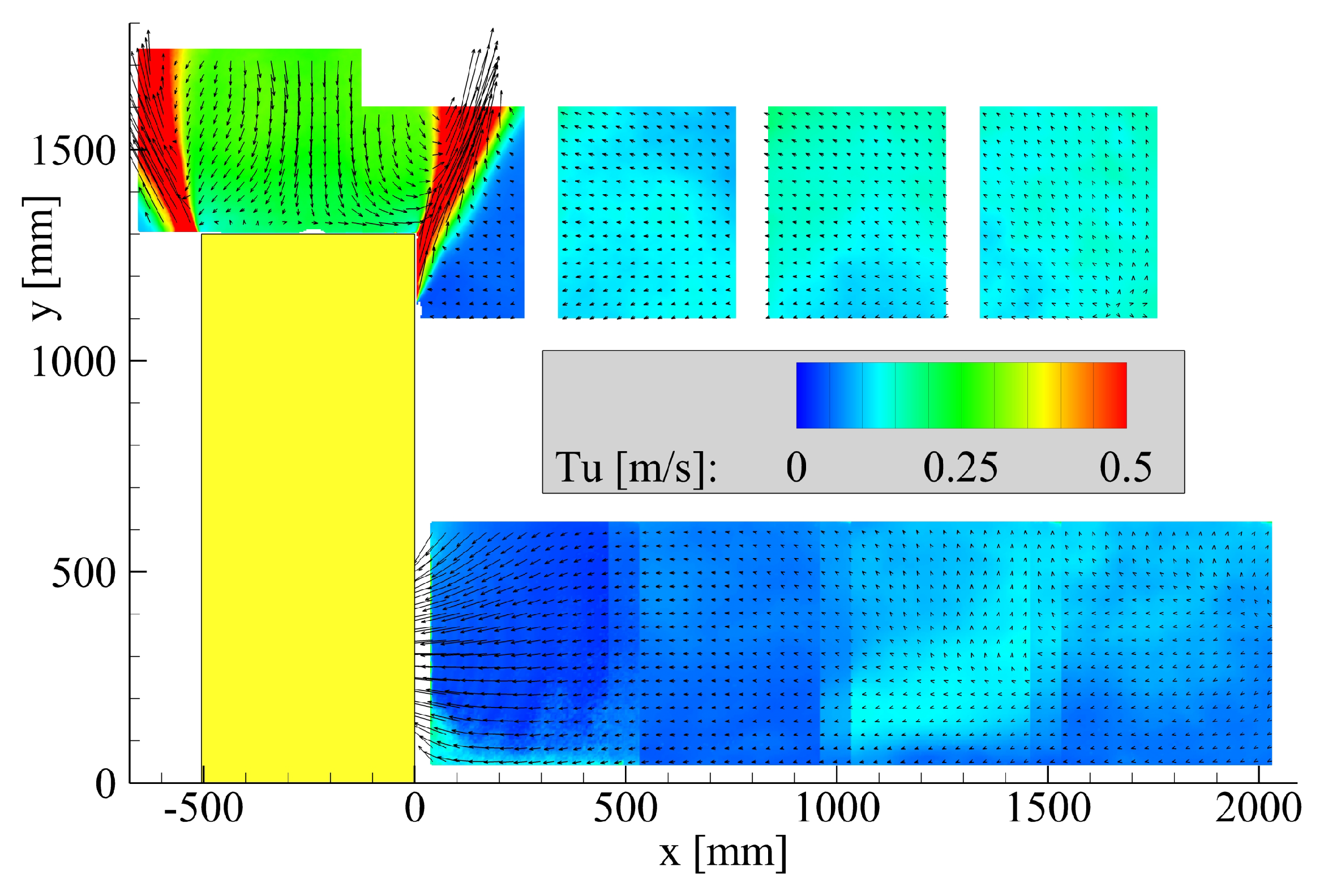Assessment of Mobile Air Cleaners to Reduce the Concentration of Infectious Aerosol Particles Indoors
Abstract
1. Introduction
2. Materials and Methods
2.1. Particle Image Velocimetry
2.2. Particle Image Counting for Decay Rate Estimation
3. Results
3.1. Comfort of Stay
3.2. Air Cleaner Filtering Efficiency
4. Discussion
Author Contributions
Funding
Data Availability Statement
Conflicts of Interest
Abbreviations
| ASHRAE | American Society of Heating, Refrigerating and Air-conditioning Engineers |
| DEHS | di(2-ethylhexyl) sebacate |
| HEPA | high efficiency particulate sir (filter) |
| HVAC | heating, ventilation, and air conditioning systems |
| PIV | particle image velocimetry |
References
- Kähler, C.J.; Fuchs, T.; Hain, R. Can mobile air cleaners effectively reduce an indirect infection risk of SARS-CoV-2 infection by aerosol particles? MMWR 2020, 70, 972–976. [Google Scholar] [CrossRef]
- Kähler, C.J.; Fuchs, T.; Mutsch, B.; Hain, R. School education during the SARS-CoV-2 pandemic—Which concept is safe, feasible and environmentally sound. medRxiv 2020. [Google Scholar] [CrossRef]
- van Doremalen, N.; Bushmaker, T.; Morris, D.H.; Holbrook, M.G.; Gamble, A.; Williamson, B.N.; Tamin, A.; Harcourt, J.L.; Thornburg, N.J.; Gerber, S.I.; et al. Aerosol and Surface Stability of SARS-CoV-2 as Compared with SARS-CoV-1. N. Engl. J. Med. 2020, 382, 1564–1567. [Google Scholar] [CrossRef]
- Lednicky, J.A.; Lauzardo, M.; Fan, Z.H.; Jutla, A.; Tilly, T.B.; Gangwar, M.; Usmani, M.; Shankar, S.N.; Mohamed, K.; Eiguren-Fernandez, A.; et al. Viable SARS-CoV-2 in the air of a hospital room with COVID-19 patients. Int. J. Infect. Dis. 2020, 100, 476–482. [Google Scholar] [CrossRef] [PubMed]
- Pyankov, O.V.; Bodnev, S.A.; Pyankova, O.G.; Agranovski, I.E. Survival of aerosolized coronavirus in the ambient air. J. Aerosol Sci. 2018, 115, 158–163. [Google Scholar] [CrossRef] [PubMed]
- Hinds, W.C. Aerosol Technology: Properties, Behaviour, and Measurement if Airborne Particles, 2nd ed.; John Wiley & Sons, Inc.: Hoboken, NJ, USA, 1999. [Google Scholar]
- Wells, W.F.; Wells, M.W. Air-Borne Infection. JAMA 1936, 107, 1698–1703. [Google Scholar] [CrossRef]
- Asadi, S.; Wexler, A.S.; Cappa, C.D.; Barreda, S.; Bouvier, N.M.; Ristenpart, W.D. Aerosol emission and superemission during human speech increase with voice loudness. Sci. Rep. 2019, 9, 2348. [Google Scholar] [CrossRef] [PubMed]
- Schumm, B.; Heiber, M.; Grätz, F.; Stabile, L.; Buoanno, G.; Schönfelder, M.; Hain, R.; Kähler, C.J.; Wackerhage, H. Respiratory aerosol particle emission and simulated infection risk is greater during indoor endurance than resistance exercise. Proc. Natl. Acad. Sci. USA 2023, 120, e2220882120. [Google Scholar] [CrossRef]
- Mutsch, B.; Heiber, M.; Grätz, F.; Hain, R.; Schönfelder, M.; Kaps, S.; Schranner, D.; Kähler, C.J.; Wackerhage, H. Aerosol particle emission increases exponentially above moderate exercise intensity resulting in superemission during maximal exercise. Proc. Natl. Acad. Sci. USA 2022, 119, e2202521119. [Google Scholar] [CrossRef] [PubMed]
- Soper, G.A. The Lessons of the Pandemic. Science 1919, 49, 501–506. [Google Scholar] [CrossRef]
- Kähler, C.J.; Hain, R. Fundamental protective mechanisms of face masks against droplet infections. J. Aerosol Sci. 2020, 148, 105617. [Google Scholar] [CrossRef]
- Solano, T.; Ni, C.; Mittal, R.; Shoele, K. Perimeter leakage of face masks and its effect on the mask’s efficacy. Phys. Fluids 2022, 34, 051902. [Google Scholar] [CrossRef]
- Shah, Y.; Kurelek, J.W.; Peterson, S.D.; Yarusevych, S. Experimental investigation of indoor aerosol dispersion and accumulation in the context of COVID-19: Effects of masks and ventilation. Phys. Fluids 2021, 33, 073315. [Google Scholar] [CrossRef]
- Fernstrom, A.; Goldblatt, M. Aerobiology and Its Role in the Transmission of Infectious Diseases. J. Pathog. 2013, 493960. [Google Scholar] [CrossRef]
- 170-2017; ASHRAE Standard 170-2017 Ventilation of Health Care Facilities. American Society of Heating, Refrigerating and Air-Conditioning Engineers: Peachtree Corners, GA, USA, 2017.
- Bagheri, G.; Thiede, B.; Hejazi, B.; Schlenczek, O.; Bodenschatz, E. An upper bound on one-to-one exposure to infectious human respiratory particles. Proc. Natl. Acad. Sci. USA 2021, 118, e2110117118. [Google Scholar] [CrossRef]
- Etheridge, D.W.; Sandberg, M. Building Ventilation: Theory and Measurement; John Wiley & Sons Inc.: Hoboken, NJ, USA, 1996. [Google Scholar]
- Küpper, M.; Asbach, C.; Schneiderwind, U.; Finger, H.; Spiegelhoff, D.; Schumacher, S. Testing of an Indoor Air Cleaner for Particulate Pollutants under Realistic Conditions in an Office Room. Aerosol Air Qual. Res. 2019, 19, 1655–1665. [Google Scholar] [CrossRef]
- Duill, F.F.; Schulz, F.; Jain, A.; Krieger, L.; van Wachem, B.; Beyrau, F. The Impact of Large Mobile Air Purifiers on Aerosol Concentration in Classrooms and the Reduction of Airborne Transmission of SARS-CoV-2. Int. J. Environ. Res. Public Health 2021, 18, 11523. [Google Scholar] [CrossRef] [PubMed]
- Curtius, J.; Granzin, M.; Schrod, J. Testing mobile air purifiers in a school classroom: Reducing the airborne transmission risk for SARS-CoV-2. Aerosol Sci Technol. 2021, 55, 586–599. [Google Scholar] [CrossRef]
- Siebler, L.; Calandri, M.; Rathje, T.; Stergiaropoulos, K. Experimental Methods of Investigating Airborne Indoor Virus-Transmissions Adapted to Several Ventilation Measures. Int. J. Environ. Res. Public Health 2022, 19, 11300. [Google Scholar] [CrossRef] [PubMed]
- EN ISO 16890-1:2016; Air filters for General Ventilation—Part 1: Technical Specifications, Requirements and Classification System Based upon Particulate Matter Efficiency (ePM) (ISO 16890-1:2016). International Organization for Standardization: Geneva, Switzerland, 2016.
- EN 1822-1:2019; High Efficiency Air Filters (EPA, HEPA and ULPA)—Part 1: Classification, Performance Testing, Marking. International Organization for Standardization: Geneva, Switzerland, 2019.
- Raffel, M.; Willert, C.E.; Scarano, F.; Kähler, C.J.; Wereley, S.T.; Kompenhans, J. Particle Image Velocimetry: A Practical Guide, 3rd ed.; Springer: Cham, Switzerland, 2018. [Google Scholar]
- Ragni, D.; Schrijer, F.; van Oudheusden, B.W.; Scarano, F. Particle tracer response across shocks measured by PIV. Exp. Fluids 2010, 50, 53–64. [Google Scholar] [CrossRef]
- EN ISO 16890-2:2020; Air Filters for General Ventilation—Part 2: Measurement of Fractional Efficiency and Air Flow Resistance (ISO/DIS 16890-2:2020). European Committee for Standardization: Brussels, Belgium, 2020.
- EN 16798-1:2019; Energy Performance of Buildings—Ventilation for Buildings—Part 1: Indoor Environmental Input Parameters for Design and Assessment of Energy Performance of Buildings Addressing Indoor Air Quality, Thermal Environment, Lighting and Acoustics—Module M1-6. European Committee for Standardization: Brussels, Belgium, 2019.
- Xue, H.; Shu, C. Mixing characteristics in a ventilated room with non-isothermal ceiling air supply. Build. Environ. 1998, 34, 245–251. [Google Scholar] [CrossRef]
- Yang, R.; Ng, C.; Chong, K.; Verzicco, R.; Lohse, D. Do increased flow rates in displacement ventilation always lead to better results? J. Fluid Mech. 2022, 932, A3. [Google Scholar] [CrossRef]





| Housing | Width × depth × height: |
| Inlet (one to the front) | Width × height: |
| Outlet (one to each side) | Width × height: |
| Position A | Position A | Position A | Position B | |
|---|---|---|---|---|
| mp1 | 3.3 | 0.21 | 4.4 | 0.16 | 6.2 | 0.11 | 3.6 | 0.19 |
| mp2 | 3.0 | 0.23 | 3.9 | 0.18 | 6.1 | 0.11 | 3.6 | 0.19 |
| mp3 | 2.9 | 0.24 | 3.7 | 0.19 | 5.7 | 0.12 | 3.4 | 0.21 |
| mp4 | 3.1 | 0.21 | 4.3 | 0.16 | 6.3 | 0.11 | 3.4 | 0.20 |
| mp5 | 2.9 | 0.24 | 4.0 | 0.17 | 6.2 | 0.11 | 3.4 | 0.21 |
| mp6 | 3.0 | 0.23 | 3.9 | 0.18 | 5.9 | 0.12 | 3.3 | 0.21 |
| decay rate k [1/h] | half-life [h] | ||||
| , Reference | ||||
|---|---|---|---|---|
| mp1 | 3.9 | 0.18 | 4.7 | 0.15 | 7.1 | 0.10 | 0.3 | 2.32 |
| mp2 | 4.0 | 0.17 | 4.7 | 0.15 | 6.9 | 0.10 | 0.6 | 1.17 |
| decay rate k [1/h] | half-life [h] | ||||
Disclaimer/Publisher’s Note: The statements, opinions and data contained in all publications are solely those of the individual author(s) and contributor(s) and not of MDPI and/or the editor(s). MDPI and/or the editor(s) disclaim responsibility for any injury to people or property resulting from any ideas, methods, instructions or products referred to in the content. |
© 2023 by the authors. Licensee MDPI, Basel, Switzerland. This article is an open access article distributed under the terms and conditions of the Creative Commons Attribution (CC BY) license (https://creativecommons.org/licenses/by/4.0/).
Share and Cite
Kähler, C.J.; Hain, R.; Fuchs, T. Assessment of Mobile Air Cleaners to Reduce the Concentration of Infectious Aerosol Particles Indoors. Atmosphere 2023, 14, 698. https://doi.org/10.3390/atmos14040698
Kähler CJ, Hain R, Fuchs T. Assessment of Mobile Air Cleaners to Reduce the Concentration of Infectious Aerosol Particles Indoors. Atmosphere. 2023; 14(4):698. https://doi.org/10.3390/atmos14040698
Chicago/Turabian StyleKähler, Christian J., Rainer Hain, and Thomas Fuchs. 2023. "Assessment of Mobile Air Cleaners to Reduce the Concentration of Infectious Aerosol Particles Indoors" Atmosphere 14, no. 4: 698. https://doi.org/10.3390/atmos14040698
APA StyleKähler, C. J., Hain, R., & Fuchs, T. (2023). Assessment of Mobile Air Cleaners to Reduce the Concentration of Infectious Aerosol Particles Indoors. Atmosphere, 14(4), 698. https://doi.org/10.3390/atmos14040698






